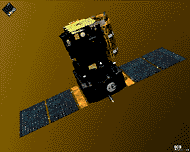SOHO
Solar and Heliospheric Observatory
 SOHO is a ESA/NASA mission to investigate the interior and exterior dynamics of the Sun. The spacecraft will perform remote measurements of the Sun and in situ measurements of the solar wind to improve our understanding of the solar interior, the dynamics of the corona, and the origin of the solar wind. SOHO is a component of the Collaborative Solar-Terrestrial Research (COSTR) Program of the International Solar Terrestrial Physics (ISTP) Program.
SOHO's specific objectives are to: (1) study and understand the solar corona, in particular
its heating mechanism and its expansion into the solar wind and (2) study the solar structure and interior dynamics from the Sun's core to the photosphere. SOHO will have the first long duration unobstructed view of the sun from its halo orbit about the L1 Lagrange point 1.5 million kilometers ahead of the Earth. In this orbit, it avoids eclipses with the Earth that block the sun. The spacecraft was built by ESA, tracking and data acquisition are shared by NASA and ESA, and mission operations are conducted by NASA.
SOHO is a ESA/NASA mission to investigate the interior and exterior dynamics of the Sun. The spacecraft will perform remote measurements of the Sun and in situ measurements of the solar wind to improve our understanding of the solar interior, the dynamics of the corona, and the origin of the solar wind. SOHO is a component of the Collaborative Solar-Terrestrial Research (COSTR) Program of the International Solar Terrestrial Physics (ISTP) Program.
SOHO's specific objectives are to: (1) study and understand the solar corona, in particular
its heating mechanism and its expansion into the solar wind and (2) study the solar structure and interior dynamics from the Sun's core to the photosphere. SOHO will have the first long duration unobstructed view of the sun from its halo orbit about the L1 Lagrange point 1.5 million kilometers ahead of the Earth. In this orbit, it avoids eclipses with the Earth that block the sun. The spacecraft was built by ESA, tracking and data acquisition are shared by NASA and ESA, and mission operations are conducted by NASA.
Spacecraft
The spacecraft consists of two modules. The service module provides power, thermal and
pointing control. The payload module contains twelve science instruments. Three-axis stabilized to within 10 arcsec, with pointing stability of 1 arcsec per 15 minutes. Power is provided by dual solar panels, with a total output of 1150 W. The payload will consume 450 W on orbit. The velocity of the spacecraft relative to the sun will be known to within 0.5 cm/sec.
Payload
GOLF (Global Oscillations at Low Frequencies) - studies the internal structure of the sun by measuring the spectrum of global oscillations in the frequency range 10-7 to 10-2 Hz.
VIRGO (Variability of Solar Irradiance and Gravity Oscillations) - provides continuous
measurements of the solar total and spectral irradiance and spectral radiance variation,
solar polar and equatorial diameters, and the frequencies, amplitudes and phases of
oscillation modes in the frequency range of 1 uHz to 8 mHz
SOI/MDI (Solar Oscillations Investigation/ Michelson Doppler Imager) - uses a telescope
with a 1024*1024 CCD camera to image the Sun. Data from the experiment is used to
understand the static and dynamic properties of the Sun's convection zone and core, as
well as contribute to our knowledge of the solar magnetic field.
SUMER (Solar Ultraviolet Measurements of Emitted Radiation) - measures profiles and
intensities of extreme ultraviolet (EUV) lines emitted in the solar atmosphere. This data
is used to understand plasma flow characteristics, turbulence and wave motions, plasma densities and temperatures, and structures and events associated with solar magnetic activity in the chromosphere, the transition zone and the corona.
CDS (Coronal Diagnostic Spectrometer) - designed to obtain spectra-spectroheliograms
in a number of lines in the EUV frequency region.
EIT (Extreme Ultraviolet Imaging Telescope) - images the solar transition region and inner corona at 4 EUV frequencies (171, 195, 284, 304 angstroms). The instrument images active regions, filaments and prominences, coronal holes, coronal "bright points," polar plumes, and a variety of other solar features.
UVCS (Ultraviolet Coronograph Spectrometer) - images the solar corona between 2 and 10 solar radii. Spectrographic images are used to calculate proton velocity distribution, proton outflow velocity, electron temperature, and specific ion outflow velocities and densities.
LASCO (Large Angle Spectrometric Coronograph) - a set of three coronagraph
telescopes that records white light and spectral images of the solar corona. Data from the experiment will be used to understand how the corona is heated, how the solar wind is accelerated, what causes coronal transients, and how large-scale structures evolve.
CELIAS (Charge, Element and Isotope Analysis System) - studies the composition of
the solar wind and solar and interplanetary energetic particles. It also monitors the
absolute EUV flux from the Sun.
COSTEP (Comprehensive Suprathermal and Energetic Particle Analyzer) -
ERNE (Energetic and Relativistic Nuclei and Electron experiment) -
SWAN (Solar Wind Anisotrophies) - measures Lyman alpha UV light scattered by
interplanetary hydrogen atoms.
| Country of Origin | ESA |
| Customer/User | ESA, NASA |
| Manufacturer(s) | Matra Marconi |
| Size | 3.65 x 3.65 m, solar array deployed: 9.5 m |
| Orbit | "Halo" about L1 Lagrange Point |
| Design Life | 2 years, 6 year goal |
| Related Sites | SOHO Home Page |
Launch Facts
| Name | Int'l Desig. | Date | Site | Vehicle | Orbit | Mass(kg) |
| Notes | ||||||
| SOHO | 1995-065A | 12/2/95 | ESMC | Atlas 2AS | Solar | 1850 |
| Solar and Heliospheric Observatory; orbiting at L1 Lagrange point; solar physics | ||||||
Information in The Mission and Spacecraft Library is provided without warranty or guarantee. USE AT YOUR OWN RISK.